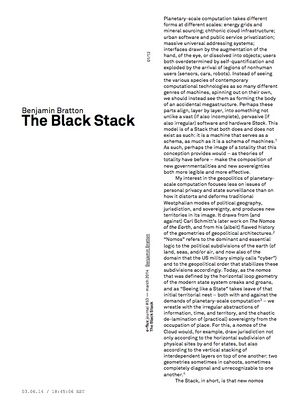Benjamin Bratton (2014) The Black Stack
Resumen
Planetary-scale computation takes different forms at different scales: energy grids and mineral sourcing; chthonic cloud infrastructure; urban software and public service privatization; massive universal addressing systems; interfaces drawn by the augmentation of the hand, of the eye, or dissolved into objects; users both overdetermined by self-quantification and exploded by the arrival of legions of nonhuman users (sensors, cars, robots). Instead of seeing the various species of contemporary computational technologies as so many different genres of machines, spinning out on their own, we should instead see them as forming the body of an accidental megastructure. Perhaps these parts align, layer by layer, into something not unlike a vast (if also incomplete), pervasive (if also irregular) software and hardware Stack. This model is of a Stack that both does and does not exist as such: it is a machine that serves as a schema, as much as it is a schema of machines. As such, perhaps the image of a totality that this conception provides would—as theories of totality have before—make the composition of new governmentalities and new sovereignties both more legible and more effective.
Archivo
Fuente
e-flux Journal #53 - March 2014
Enlaces
URL: http://www.e-flux.com/journal/the-black-stack/
Wayback Machine: https://web.archive.org/web/20160626034716/http://www.e-flux.com/journal/the-black-stack/
